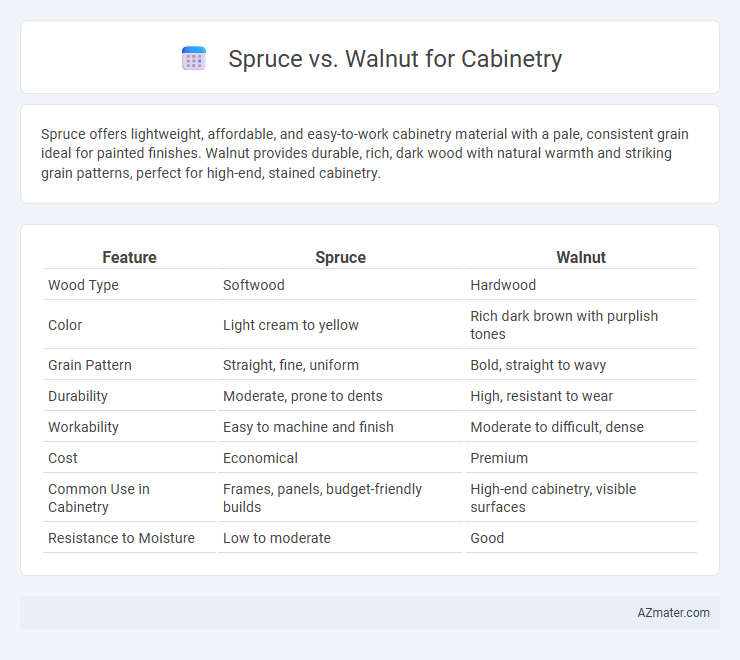Spruce offers lightweight, affordable, and easy-to-work cabinetry material with a pale, consistent grain ideal for painted finishes. Walnut provides durable, rich, dark wood with natural warmth and striking grain patterns, perfect for high-end, stained cabinetry.
Table of Comparison
| Feature | Spruce | Walnut |
|---|---|---|
| Wood Type | Softwood | Hardwood |
| Color | Light cream to yellow | Rich dark brown with purplish tones |
| Grain Pattern | Straight, fine, uniform | Bold, straight to wavy |
| Durability | Moderate, prone to dents | High, resistant to wear |
| Workability | Easy to machine and finish | Moderate to difficult, dense |
| Cost | Economical | Premium |
| Common Use in Cabinetry | Frames, panels, budget-friendly builds | High-end cabinetry, visible surfaces |
| Resistance to Moisture | Low to moderate | Good |
Introduction to Spruce and Walnut for Cabinetry
Spruce and walnut are popular choices for cabinetry, each offering distinct characteristics. Spruce is a lightweight softwood known for its pale color, straight grain, and ease of working, making it ideal for painted cabinets or budget-friendly projects. Walnut is a dense hardwood valued for its rich, dark brown color, natural durability, and striking grain patterns, often used in high-end or feature cabinetry to create a luxurious, classic aesthetic.
Physical Characteristics: Spruce vs Walnut
Spruce features a light color with fine, straight grain and a relatively soft texture, making it easy to work with but less durable compared to hardwoods. Walnut exhibits a rich, dark brown hue with a pronounced, wavy grain pattern and a dense, hard texture that provides superior strength and resistance to wear. The distinct physical characteristics of spruce and walnut influence their suitability for cabinetry, with spruce favored for lighter, budget-friendly applications, and walnut prized for premium, long-lasting furniture.
Color and Grain Differences
Spruce cabinetry offers a light, creamy color with a fine, straight grain, creating a clean and subtle aesthetic ideal for bright, airy spaces. Walnut features a rich, deep brown hue with dramatic, swirling grain patterns that add warmth and sophistication to any room. The contrast between spruce's pale, uniform texture and walnut's darker, textured grain allows for versatile design choices depending on the desired visual impact.
Durability and Strength Comparison
Spruce offers moderate durability and strength suitable for lightweight cabinetry but may show wear under heavy use, whereas walnut is renowned for its exceptional hardness and resilience, making it ideal for long-lasting, high-quality cabinets. Walnut's dense grain structure enhances its resistance to dents and scratches, outperforming spruce in maintaining structural integrity over time. For cabinetry requiring robust durability and strength, walnut represents a superior choice compared to spruce.
Workability and Ease of Machining
Spruce offers excellent workability due to its soft texture, making it easy to cut, shape, and sand for cabinetry projects. Walnut, being a hardwood, provides a denser grain that requires sharper tools and more careful handling but results in a smoother finish and greater durability. Both woods machine well, but spruce is preferred for intricate designs and faster production, while walnut excels in custom, high-end cabinetry where detail and finish quality are paramount.
Cost and Availability of Spruce and Walnut
Spruce cabinetry is generally more affordable due to its widespread availability and faster growth rate, making it a cost-effective option for budget-conscious projects. Walnut, known for its rich color and durability, commands a higher price because of limited availability and slower growth, often resulting in premium costs for cabinetry. Availability of spruce is consistent across North America and Europe, while walnut is less abundant and sometimes sourced from specific regions, impacting overall price and delivery times.
Maintenance and Longevity
Spruce cabinetry requires regular sealing and protection against moisture to prevent warping and decay, making its maintenance more demanding compared to walnut. Walnut cabinets are naturally more resistant to wear, moisture, and insect damage, ensuring greater longevity with minimal upkeep. Both woods benefit from periodic cleaning, but walnut's durability and stability provide a longer-lasting investment for high-traffic kitchen environments.
Environmental Impact and Sustainability
Spruce cabinetry is favored for its rapid growth rate and renewable harvesting, making it a highly sustainable wood choice with a lower carbon footprint compared to slower-growing hardwoods. Walnut, while prized for its rich color and durability, has a higher environmental impact due to longer maturation times and less abundant availability, often leading to more intensive forestry practices. Choosing spruce over walnut can significantly reduce deforestation risks and promote sustainable forest management in cabinetry production.
Best Applications in Cabinetry Design
Spruce, known for its lightweight and affordability, is ideal for painted cabinetry and applications requiring easy customization in contemporary kitchen designs. Walnut offers exceptional durability and rich grain patterns, making it a premium choice for high-end cabinetry where aesthetic appeal and longevity are prioritized. Both woods perform well in cabinet framing, but walnut excels in visible panels due to its natural elegance, while spruce is preferred for hidden structural components.
Choosing Between Spruce and Walnut: Key Considerations
Spruce offers a lightweight, budget-friendly option with a pale color and straight grain ideal for painted or rustic cabinetry, while walnut provides a rich, dark tone and distinctive grain patterns suited for high-end, elegant finishes. Consider factors such as durability, with walnut being harder and more resistant to dents and scratches compared to the softer spruce, which may be more prone to wear in high-traffic areas. Environmental impact and availability also play roles, as spruce grows faster and is more sustainable, whereas walnut is slower-growing and typically more expensive.

Infographic: Spruce vs Walnut for Cabinetry
 azmater.com
azmater.com